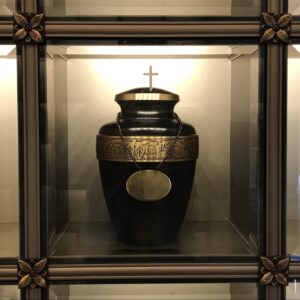 Catholic Cemeteries encourages cremation burial to follow the same process as a funeral with a casket. Use of a funeral director’s services, funeral mass at the parish, and a blessing at the grave-side, crypt or cremation niche is recommended and encouraged. However, cremation affords families the occasion to handle burial arrangements without the assistance of a funeral director. For these arrangements, the following procedures and guidelines are recommended for your review.
Catholic Cemeteries encourages cremation burial to follow the same process as a funeral with a casket. Use of a funeral director’s services, funeral mass at the parish, and a blessing at the grave-side, crypt or cremation niche is recommended and encouraged. However, cremation affords families the occasion to handle burial arrangements without the assistance of a funeral director. For these arrangements, the following procedures and guidelines are recommended for your review.
Cremation Committal Services at Catholic Cemeteries:
- For in-ground burials, urns should not exceed 12 ½ ” x 6 ” x 7 ½” in order to fit our cemetery urn vault.
- For cremation niches, maximum urn size will vary based on niche type and location. Please review the printed rules and regulations for size requirements.
- Note: Glass front cremation niches have additional regulations concerning the overall characteristics of urn type, composition, inscription, epitaphs, etc. Please review with a cemetery representative prior to purchasing an urn for a glass front niche.
- Families should appoint one member as a spokesperson to contact the cemetery office to make arrangements. Please contact the cemetery one to two weeks before the intended burial date.
- Cremated remains should NEVER be mailed to the cemetery office.
- Families completing arrangements without a funeral director are REQUIRED TO PRESENT IN PERSON OR VIA FAX/EMAIL all documents to the cemetery office at least one week before the committal service.
- Additional concerns
- Late fees apply at the time of arrival at the cemetery office.
- Cancellation fees apply for canceling a scheduled committal service without proper notice.
Please review our Cremation Planning Guide Brochure for additional details.
To schedule a committal service for cremated remains, click here to complete an online form or contact the cemetery office.
FAQ about Cremation:
What is the Catholic Teaching on Cremation?
Cremation is permitted for Catholics as long as it is not chosen in denial of Christian teaching on the Resurrection and the sacredness of the human body. Although cremation is permitted, Catholic teaching stresses the preference for burial or entombment of the body of the deceased. This is done in imitation of the burial of Jesus’ body.
What are the steps to be taken if one chooses cremation?
When cremation is chosen, the full course of the Order of Christian Funerals should still be celebrated, including the Vigil Service (wake), the Funeral Liturgy, and the Rite of Committal. The preservation of this order allows for the greater expression of our beliefs and values, especially, the sacredness of human life, the dignity of the individual person and the resurrection of Jesus Christ.
Should cremation occur before or after the funeral?
The Church clearly prefers and urges that the body be present during Vigil and Funeral Mass. Also that if cremation is to be used, it take place following the Rite of Final Commendation. The cremated human remains would then be interred during the Rite of Committal. The diocesan bishop has permitted cremated remains to be present for the Funeral Liturgy.
What should become of cremated remains following the funeral?
Church teaching insists that cremated remains must be given the same respect as the body, including the manner in which they are carried, and the attention given to their appropriate transport and placement. The cremated remains of a body are to be buried or entombed, preferably in a Catholic cemetery, and using the rites provided by the Order of Christian Funerals.
The following are not considered to be reverent dispositions that the Church requires: scattering cremated remains, dividing cremated remains and keeping cremated remains in the home. The remains of a cremated body should be treated with the same respect given to the corporeal remains of a human body. This includes a worthy container to hold the cremated remains.
Helpful Documents on Cremation
Cremation Planner
Catholic Cemeteries of Long Island Cremation Video
Vatican Guidelines
Why a final resting place for cremation remains important?
Teaching on Cremation
Urn Catalog
